Monuments in St Peter’s Collegiate Church, Wolverhampton
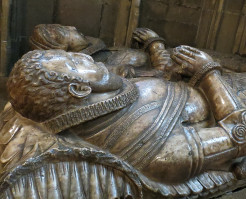
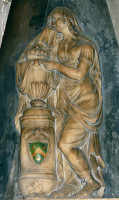
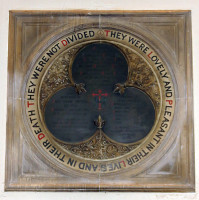
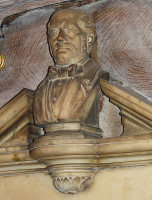
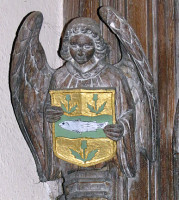
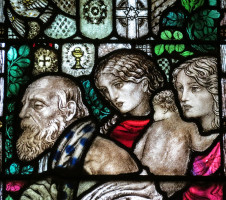
History of the Church
The Collegiate Church of St Peter, Wolverhampton is the main church of the city,
and is the natural centre of the conurbation, a most beautiful Medieval creation made in the typical reddish stone
of the area.
The history of the Church goes back far beyond that, to the 8th Century, when Wulfere, King of Mercia
converted to Christianity and had various monasteries and churches built in his great territories, including,
it is thought, in Wolverhampton. Later in the 10th Century Wulfruna, widow of Athelme, Earl of Northampton
and relative of Ethelred II, re-endowed the Church, providing it with lands to maintain a monastery,
dean and secular canons, hence a Collegiate Church (as opposed to a Cathedral or church under the control of a bishop).
William the Conqueror gave it to his new Bishop of Worcester, and after many changes of ownership in later years,
the canons again gained freedoms and privileges. By the 14th Century, the Church was somewhat dilapidated,
and in the 15th Century it was converted into a chancel for a new, larger church which was built on the site:
while the old chancel is long gone, it is the 15th-16th Century Church we largely see today.
At that time too the still existing pulpit, much renowned, was erected.
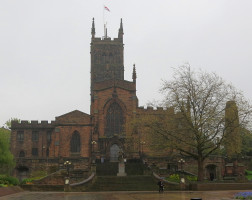
The interior was rather damaged in the time of Henry VIII, and again during the Civil War,
when Cromwell’s troops damaged and destroyed tombs, though a few excellent examples survive.
Finally, the mid-19th Century saw a restoration of the interior, and rebuilding of the chancel and addition of an apse.
And now to the monuments. There are something over two dozen, plus a group of late 19th Century diamond-shaped
epitaphs along one wall. The earliest is the large John Leveson Monument of 1575, with two recumbent effigies.
Then a dozen from the 17th and 18th Centuries, with the balance from the 19th Century.
While the earlier monuments are the most significant, the later ones are of interest too,
with one figural piece and a couple with a Gothic tendency.
Monuments: 16th Century Chest Tombs
John Leveson, d.1575, and Joyce Leveson, d.1571,
attributed to the sculptor Robert Royley of Burton on Trent. Two recumbent effigies on a great chest tomb,
in a brownish alabaster. As with tombs from earlier times, their faces are rather rounded, with the projections
of nose and brow, and the indentations for eyes and cheeks rather slight. John Leveson wears a cuirasse,
a chain wrapped twice around his chest, and some sort of tunic above his armoured legs.
His hair is cut straight round the sides, and he his head protrudes from the usual ruff of monuments of this age.
The lower arms are missing, as are the feet. Joyce Leveson is elegantly slim at the waist and in the arms,
and wears a jacket closed at the front and with tight arms. Below, long skirts cover the feet, with no effect
of gravity shown in the horizontal lines of drapery. Both figures lie of high cushions.
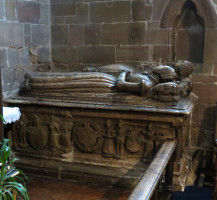
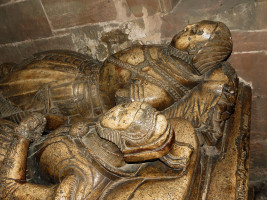 Tomb of John and Joyce Leveson, 1570s, attrib. to Robert Royley.
Tomb of John and Joyce Leveson, 1570s, attrib. to Robert Royley.
The front of the tomb has a panel with six standing figures, three of which are damaged.
It is not clear what they are doing: the two rightmost each have an outstretched arm above a shield.
The faces are partially scratched out, but the figures remain an evocative Renaissance group.
Thomas Lane, and Katherine Lane/, 1582, a second chest tomb,
surely one of the sights of Wolverhampton, with recumbent figures of the deceased lying in stately pomp on top,
and a line of carved figures in high relief on the long side, and three coats of arms on the exposed short side,
all in brownish alabaster. The two principal figures lying on top are richly dressed,
with large ruffs at their necks, smaller ones at their wrists, and wearing rings on their fingers.
Thomas Lane is in armour, decorated with scrolls and repeating designs. As with the Leveson monument,
the features are rather flattened. He has carefully carved, short wavy hair, and a rather plainer beard.
Katherine Lane has a banded hairstyle, and an embroidered skirt. Each has their arms across their breasts
and their hands in prayer. They lie on pillows, hers being the more rich with tassels at the corners.
The monument has been moved, likely from where Colonel John Lane’s monument now stands, and at that time
lost its surrounding iron railings.
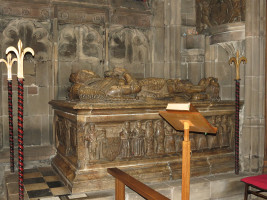
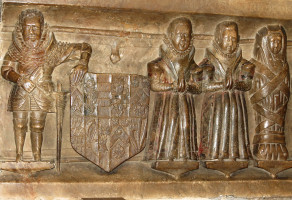 Thomas Lane and Katherine Lane, d.1582, and some of their children.
Thomas Lane and Katherine Lane, d.1582, and some of their children.
The front panel contains a row of kneelers – small kneeling figures representing the offspring of the family.
Unusually, these are facing forward rather than sideways. To the right are seven similar girls, the daughters.
Then, centre left are two swaddled babes, of similar vertical size for compositional reasons,
who may have died as infants. Then two sons, shown fairly youthful, and beardless.
Then a shield, and on the other side a single standing male figure leaning upon it, a sword by his side;
this might be a representation of Thomas Lane in life. Or not. Gerald Mander, the Wolverhampton antiquary,
puts this figure, along with the two boys and the two infants, as the five sons of Thomas Lane,
and reads the rather Gothic inscriptions above them rather better than I was able.
He gives them as Robert Lane, Thomas, Mychaell, Edward, and George, the last of whom certainly died at a little
over a year old. The girls are Margarett, Cassandra, Audrey, Martha (?), Sarah, an unknown one, and Alce [Alice].
The figures are rather disproportionately, but very spiritedly carved.
A note in the Church states that the tomb was sculpted by the Royleys of Burton on Trent;
other sources state specifically Robert Royley.
Statue of Vice Admiral Richard Leveson, by Hubert le Sueur
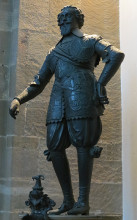 Le Sueur's statue of Richard Leveson, d.1605.
Le Sueur's statue of Richard Leveson, d.1605.
Vice Admiral Richard Leveson, d.1605, an excellent bronze statue by Hubert le Sueur,
surviving from a large monument destroyed at the time of Cromwell, along with two reclining cherubs,
a coat of arms, and an inscribed panel. This is a rare surviving statue by Hubert le Sueur,
sculptor and bronze caster to Charles I, whose most well-known statue is the equestrian figure of that monarch
in Trafalgar Square (see this page for pictures).
The armoured figure is jauntily posed and with something of self-important grandeur. See this page for more on this statue.
Other 17th Century Monuments
- William Walker, d.1634, ‘Gent of ye Castle of Windsor, Whoe served Childe of the Chappell
of St George 7 yeares to Queene Elizabeth. And 6 yeares to King James. And deceased Organist of this place’.
It consists of a plain Gothic window border, with the text written on the lower part, and a large painted coat of arms
above – the whole thing seems to be of wood, unusually.
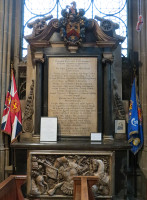
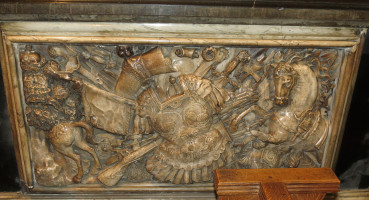
Col. John Lane, d.1667, and detail of the Trophy.
- Colonel John Lane, d.1667, a grand wall monument with trophy and cannon.
The central panel, with long Latin inscription, is within a dark frame with Ionic pillars to the sides,
and outer scrolly side-pieces with carved fruit. Above, a curly open and broken pediment,
bearing within it a large shield of arms surrounded by Acanthus leaves, the usual knight’s helm on top,
and on top of that a rearing horse, all painted. On the sides of the pediment are two upward-pointing cannon,
a splendid accoutrement for a monument. Beneath, a panel with an architectural trophy,
that is to say a carved display of crossed weapons, in this case with a cuirass, or suit of chest armour in front.
But there is much more than this. Firstly, the weapons are rather showy, with a mix of bladed weapons,
including one with a ram’s head hilt, another with some eagle head, a long gun, some brass instrument,
and a hanging flag with a Germanic cross upon it. Also in the panel are a single leg of armour, a helm,
a horse prancing inward on the right, and the rear of another exuent left behind a tree;
altogether a remarkable, inventive and idiosyncratic piece of sculpture. Picture above, which you will need to click on to see the detail.
A translation explains that John Lane was a distinguished soldier,
‘a man superior to titles, and to whose merits there are none more adequate’,
and to judge from the quality of the monument, it must indeed be so.
He was a colonel under Charles I and Charles II, apparently rescuing the latter after the battle of Worcester.
A second note explains that the tomb was emplaced after his death in 1677 (it means 1667),
and that it was probably the work of Jaspar Latham, who made similarly-designed tombs elsewhere.
- An undated part of a panel, a carved frieze really, showing a coat of arms in a roundel
with a motto, held by two preposterously proportioned and grossly obese putti, crude in the carving,
with effort put in only to the faces and hair. This thing is on the wall below the John Thomas Lane memorial
noted below (see picture; you will need to click to enlarge), and presumably is of 17th Century date.
- Richard Bracegirdle, d.1677, apothecary of Wolverhampton, and relations,
with long Latin inscription, closely packed on an almost square panel with a narrow border, and two small brackets.
18th Century Monuments
- Henry Bracegirdle, d.1702, Sacrist of the Church and son of Richard Bracegirdle,
with a Latin inscription, a Classical tablet with side attached Tuscan pillars, entablature, and empty curved pediment.
At the base, a heavy shelf with jelly-mould apron and two side corbels carved as bunches of grapes
emerging from surrounding leaves.
- Thomas Bracegirdle, d.1715, and his two wives, Mary, daughter of John Gibbons,
by whom he had eight children, and and Sarah, another daughter of John Gibbons,
and noting he beautified the Church in 1705. He was the cousin of Henry Bracegirdle,
above, and at one time the two monuments were on opposite sides of the choir.
The inscribed panel has Tuscan pillars to the sides, and above, a plain entablature and a curved pediment,
rather oversized and looking top heavy. At the base, a heavy, broad shelf, with two corbels or brackets
crudely carved as clusters of grapes projecting out of leafy wrappings.
Between them is a fat-faced winged cherubic head, a gross object indeed.
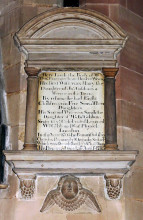
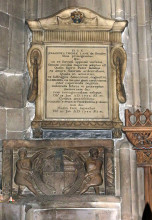
Monuments to Thos. Bracegirdle, d.1715, John Thomas Lane, d.1782, and the ghastly putti.
- Epitaph by Dr Wilkes, d.1732, but to whom I could not discern.
The Wilkes family was well established in the area since at least the 15th Century,
and this monument may be to one of his progenitors. One of the panels with thin black letters chiselled
on a dark background, with a thin border. The rendering of the epitaph is underneath on a pale panel.
- Thomas Rowley, d.1757, on a dark slaty panel, undecorated.
- James Augustus Whitley, d.1781. Panel with small pediment and striated apron
like an upturned umbrella, with a pendant at the base. Little buttons with stylised flowers in relief.
- John Thomas Lane, d.1782, of Bentley, and wife Sarah d.1784, with Latin inscription.
The panel has an unusual surround, with the curly side-pieces sometimes found, but with the curled bit
at the top rather than being the lower part, which is unusual. In the centre of each curl is a stylised,
elongated flower, from the centre of which depends a great festoon of leaves,
as if the monument had two ponderous handles. Above, a ribbed entablature, and a curved, low pediment,
almost borderless, enclosing a shield of arms, painted, with small carved festoons and a ribbon.
At the base, a repeating wave pattern, two brackets carved with leaves, and a plain, shallow strip of dark stone
between which may be a later addition. He was of the illustrious Lane family, and she was the daughter and
coheiress of Richard Fowler of Pendeford, Staffordshire.
- John Hillman (?), d.1790 (?), a brownish, with pale border, and outer dark border with a top.
- Sarah Illidge, d.1791, and husband William Illidge, 1793 (the surname of the family
is recorded elsewhere as ‘Illedge’), and offspring to 1833, panel with upper shelf above an entablature,
if so we can call it, bearing five small carved devices, roughly square in shape, of stylised flowers,
on a black backing.
- Mander, gent, in the shop and with the date covered, an egg shaped white panel,
on a black and grey marble backing, with gently pointed top bearing a low relief of a classical pot.
Presumably an antecedent of the antiquary Gerald Mander, of whom a number of relatives achieved prominence in Wolverhampton society.
19th Century Monuments
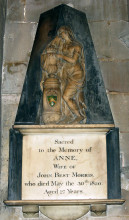 Obelisk monument to Anne Morris, d.1820.
Obelisk monument to Anne Morris, d.1820.
- Anne Morris, d.1820, an obelisk monument with a sculpture of a mourning girl (see picture above and at top of page).
An interesting work – the standing female figure has one hand touching, almost caressing, a funeral urn;
her other arm, which can just be made out, has its elbow on the body of the urn, and is partially veiled in the piece
of drapery she holds to her face, indicative of wiping a tear in an act of mourning. She wears light drapes,
including a short-sleeved top, an almost ankle-length figure-hugging shift or chiton,
and with a sweep of outer drapery, a cloak or himation if you will, around her body and up and over her head
to form a sort of veil; it merges indistinguishably with the bit of drape used as the handkerchief.
So far so conventional. But the style is quirky and interesting; the girl is anything but Grecian
in the proportions of her face, has a long, spare neck, and wears the head covering like a Victorian old maid.
The proportions of her body are Gothic rather than Classical, her arm fleshy, knee rather bony,
and ankle and sandalled feet quixotic. There are well-observed parts to the drapery, but some mistakes of proportion,
with the further foot being much larger than the nearer one, and her breasts under the thin fabric being awkwardly
placed and unconvincing. The pot, itself draped and with jelly-mould patterning,
sits on top of a tall plinth with relief flowers at the base, and on the front, a painted shield of arms.
There is no obvious signature, and this is likely provincial work by some sculptor
venturing rather beyond his capacity. Yet somehow the whole is rather endearing, the very deficiencies
of the modelling giving some character to the girl.
- Revd. Thomas Walker, d.1834, Sacrist, Prebendary and Reader of the Church, and wife
Diana, d.1834 as well. Beneath, a separate panel to the Revd. Thomas Walker, d.1861,
‘Prebendary of Featherstone in this Church’, and his wife, Elizabeth, d.1881.
The upper panel is encased in a Gothic surround, with attached hexagonal pillars to the sides,
a fairly flat pointed arch, with wavy embellishments on top and some small floral decoration carved in the middle.
The second panel is attached directly underneath, thus with a pair of pilasters to the sides of the same width
but lesser height, and a similar honey-coloured or stained white marble. All on a black backing,
itself surrounded by a larger, plain Gothic stone window surround, with the upper and side parts of a cross
at the top, creating room for two spandrels with simple trefoil decoration.
- Richard Fryer, d.1846, first MP for the Borough and supporter of the repeal of the Corn Laws.
Plaque with cusped top, and a roundel within which is a profile bust of the deceased in high relief.
On a grey backing. Signed but I could not read it.
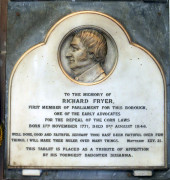
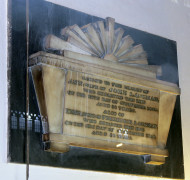 Fryer and Langman tablets, mid-19th Century.
Fryer and Langman tablets, mid-19th Century.
- John Langman, 1848, and wife Emma d.1842, styled as a casket end,
with a certain chunkiness in all its proportions, including the inscribed text.
On the top is a sunburst which could have come straight out of the Deco period a hundred years later.
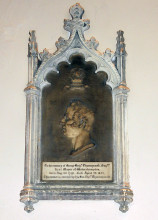 G. B. Thorneycroft, d.1851, by Thos. Thornycroft.
G. B. Thorneycroft, d.1851, by Thos. Thornycroft.
- George Benjamin Thorneycroft, d.1851, first Mayor of Wolverhampton,
the tablet erected by his son, Thomas Thorneycroft [Thomas Thornycroft],
the well known sculptor, himself father of Hamo Thornycroft,
by which time the ‘e’ in the name had been completely lost. With a relief bust in profile, showing an elderly man,
with high forehead and craggy face. The neck is shown bare rather than with collar, giving a Classical look
to the work. However, the setting is Gothic, in the form of an ogee-tipped window with crockets and two pinnacles,
all in stone.
- James Rowlison, d.1811, wife Hannah, d.1816, and daughter Ann, d.1836,
erected by the grandson, John Rowlison Pretty, in 1857. A plain white tablet with minimal upper and lower shelves
and feet, on a shaped black backing. By Weale, a Wolverhampton statuary who has several tablets in Bilston Church.
- Amprell monument, 1863 etc, rather high up and with the text finely cut perhaps on slate,
so I could not really make it out. Three individuals are commemorated, in three intersecting circles with a cross
in the centre, so they form a trefoil shape, within a circle with an outer border on which there is an inscription,
‘They were lovely and pleasant in their lives and in their death they were not divided’.
The whole within a square stone border with blank spandrels, but the inner spandrels between the circles,
if we can call them that, are carved ornately with stars and leafy branches - a picture is at the top of this page, 3rd along.
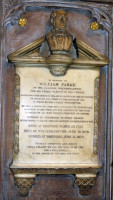 William Clarke, d.1876, with bust.
William Clarke, d.1876, with bust.
- William Parke, d.1876, warden of the church, with a bust. T
he monument is styled as a rather spare classical monument, with the normal side pilasters replaced by a
band of carving of repeated groups of berries or flowers, rather indistinct, further repeating patterns at the base,
and two large supporting brackets with low relief little flowers etc. The bust is at the top,
occupying a broken pediment, and based on a small corbel with carved leaves.
The subject is shown in middle age, heavy of face, with a short beard and sideburns, and a domed forehead.
He wears a clerical collar, bow tie and buttoned shirt under a jacket; the chest area has been cut rather small,
making the head look over-large, an uneasy compromise to fit the bust within the pediment space and have the line
of the slanted edges carried on to the shoulders. Nevertheless, the face itself has some character
and the whole is an interesting piece. William Parke is of interest to these pages as having made a record
of the inscriptions on the various tombstones on the floor of the chancel before they were obliterated by rebuilding. A close-up
of the portrait bust is at the top of the page.
- Frederick Barnwell Gibbs, d.1891, and George Clayson Gibbs, d.1893,
a Carrara marble panel, square, without ornament bar an inscribed border with little crosses and circles
at the corners and simple crucifixes and a crown.
- John Thomas Jeffcock, Rector, erected 1896, brass panel with black letter text,
red for his name and a few capitals in a common style of the time, and a border of little flowers and
railway decoration.
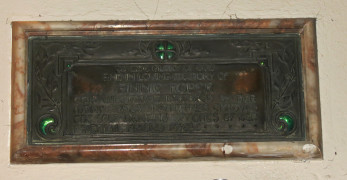
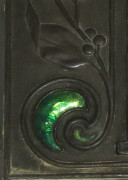 Annie Roper bronze panel, and detail of enamel.
Annie Roper bronze panel, and detail of enamel.
- Annie Roper bronze panel in beaten bronze, with an outer border of coloured alabaster,
and three small patches of dark green enamel in the decorative, leafy art nouveau inner border,
lustrous and jewel-like. There is no date but this must be from the 1900s. An excellent thing.
There are also a number of plain Carrara marble square memorial panels set into the wall,
each with a simple inscribed black border, and no other decoration bar the odd small crucifix.
They date from the 1870s through to the 1900s (see picture below).
Various lozenges commemorating late 19th Century congregationers set into the wall,
e.g. Sara Elsam, d.1875, with a quatrefoil in white and leaf patterns in the spandrels. And a number of
modern brasses of the black-letter with red capitals type, with more or less ornament and similar date.
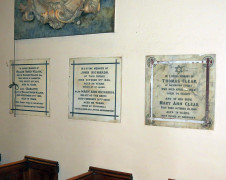
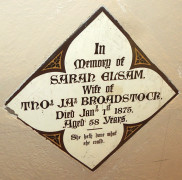
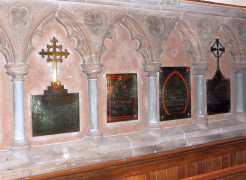
Late 19th Century panels.
Also in St Peter's Church
There are several war memorial panels which we may note:
Also to be seen are the following:
- The Font, 15th Century apparently, has eight carved figures around the base.
Each is in a Gothic niche, and is large within the available space, a particularly medieval method of design.
The figures, some of which have lost their faces, are rather squat, with oversized heads,
but have a satisfying solidity and weightiness.
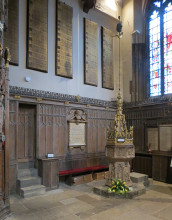
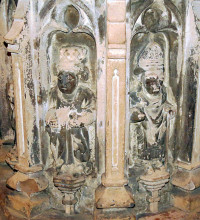 15th Century Font and sample sculpted figures.
15th Century Font and sample sculpted figures.
- A 19th Century cast of the Saxon column which stands outside the Church,
which is surmised as part of a Cross. It is covered with carvings, including an eagle with a neck ring
and various beasts characteristic of the era.
- A profile of Christ, in relief on metal, perhaps a lead alloy,
mounted within a wooden frame, entitled ‘PAX’. A sensitive rendering, looking rather modern and extremely serious
in expression.
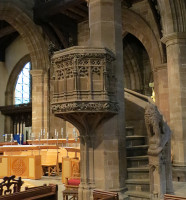
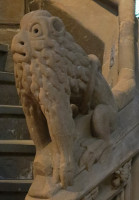 1480 Pulpit, and the Lion statue.
1480 Pulpit, and the Lion statue.
- The Pulpit, an ancient one dating from 1480, which according to a sign upon it,
is unique in having the ancient stone staircase round one of the south pillars of the nave
in a state of complete preservation. It also notes that the coat of arms is that of Swinnerton,
and propose that family as the donors, or at least funders, of the pulpit.
The best sculpture is the lion at the bottom on the banister, a solid little beast, with massive front legs,
frog-like back ones, a coiled tail, and the almost monkey-like head protruding from a huge mane with no sign of a neck.
- The South Door and Lobby, put up as a memorial to Sir Charles Terius Mander,
1st Baronet, presented by members of his family. A full description of this grand and decorative structure
is given in the Church. The grand wooden structure includes two full figures, again carved in wood,
depicting Thomas a Becket and Charles I – the latter particularly appropriate in view of the
Leveson statue noted above. A picture of one of the carved half-angels from this door is at the top of the page.
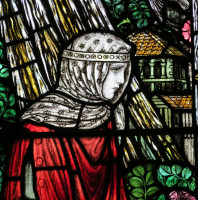
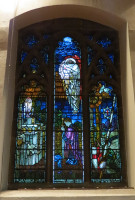

Examples of St Peter's stained glass.
- Stained Glass – some extremely good panels, including some charming Pre-Raphaelite girls,
and work by Burne Jones, with William Morris’s fantastically deep coloured blues and purples and greens,
above all the praying knight. Among much other worthy glass, look out for the figure of St Jerome
with a small lion rearing up affectionately against him.
Thanks to the Church authorities for permission to show pictures of the various monuments from inside the Church; the Collegiate Church of St Peter's website is at
http://www.wulfruna.org.uk/index/petersChurch/.
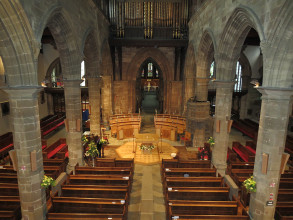
Top of page
Introduction to Wolverhampton sculpture // Sculpture around the Church in St Peter's Gardens // St John's Church in the Square, Wolverhampton
Bilston Church // St Bartholomew's Church in Wednesbury // Birmingham // Sculpture in some towns in England // Sculpture pages // Introduction to church monuments
Wilmot of Wolverhampton
Home
Visits to this page from 21 June 2014: 4,546 since 20 October 2021







 Tomb of John and Joyce Leveson, 1570s, attrib. to Robert Royley.
Tomb of John and Joyce Leveson, 1570s, attrib. to Robert Royley.

 Thomas Lane and Katherine Lane, d.1582, and some of their children.
Thomas Lane and Katherine Lane, d.1582, and some of their children.
 Le Sueur's statue of Richard Leveson, d.1605.
Le Sueur's statue of Richard Leveson, d.1605.


 Obelisk monument to Anne Morris, d.1820.
Obelisk monument to Anne Morris, d.1820.